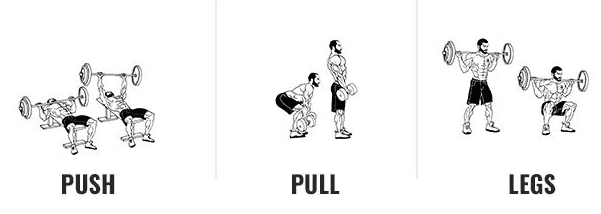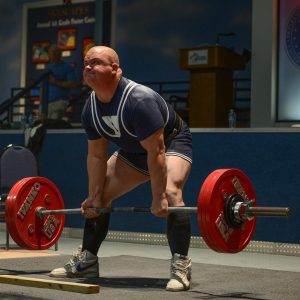If you say you’re into fitness, you must’ve heard about push pull legs somewhere somehow. Maybe some meathead at the local gym mentioned it or your gym rat friend won’t shut up about it.
Regardless, this training split has piqued your taste buds and rightfully so. It’s an infamous training split that’s packed on thousands of pounds of muscles across numerous lifter for decades. It’s simplicity and effectiveness is potent, but just like anything else in life, it must be implemented correctly.
So, here’s everything you need to know along with everything you didn’t know you need know about PPL.
What is Push-Pull-Legs?
PPL is a training split where you train a set a muscle groups with minimal overlap. You essentially rotate between training your upper body pushing muscles, your upper body pulling muscles, and your lower body.

Does the Push Pull Legs Order Matter?
No, not really. Starting with push and ending with legs is merely tradition due to the order in the name.
I prefer placing faster twitch muscles earlier in the week, so push is a good place to start with. Starting with legs is also common because the legs are usually highly demanding to train thus, doing them early in the week makes sense. Not to mention, many guys don’t like training legs, so they prefer to get it over with early.
Ultimately, these are the muscle groups you’ll train on their respective days.
- Push day: chest, shoulders, and triceps (some people add calves or abs here too)
- Pull day: back (lats, erectors, rhomboids, traps) and biceps (some people add rear delts and/or forearms here too)
- Leg day: quads, hamstrings, glutes, calves (some people add abs here too)
Why Do Push-Pull-Legs?
PPL allows you train muscles with minimal overlapping fatigue. For example, if you went a bit overboard with the intensity on leg day, it won’t affect your next 2 workouts as they don’t involve your legs.
Your legs will have plenty of recovery time until your next leg session.
With minimal overlap, it also makes programming effortless. You know exactly what muscles to hit on which day.
You can do PPL anywhere between 3-6 days a week as you see fit. You can also do more of the days that you desire to specialize in. For example, with a 4-day per week setup, you can do 1 push, 2 pull, and 1 legs if you desperately need to grow your back and biceps.
Is Push-Pull-Legs Good For Beginners?
Absolutely. For starters, it’s simple and each workout takes relatively the same time which is great for beginners. Compare that to something like an upper/lower split which may have incongruent workout times as upper body days generally take longer.
And as discussed earlier, PPL is easily customizable. Beginners can start with a 3-day per week PPL and move towards a 6-day per week PPL when appropriate.
Is 3 Day Push Pull Legs Enough?
Yes, for people short on time or beginners, 3 days is sufficient. Research shows higher training volume and frequencies tend to benefit more advanced lifters (1). Studies show no difference in higher training frequencies in beginners (2).
Beginners don’t recover as well and experience more muscle damage, but once you’ve built up enough recovery capacity, 6 days per week is deeply doable (3).
That’s where the real magic happens as you get to train every muscle twice per week with more weekly volume. 6 days per week is my ultimate recommendation, but be sure you build up to it.
Push-Pull-Legs Program
When setting up a PPL split, you can setup a push, pull, and legs workout and repeat them each once during the week. That’s the simple route and works great if you’re limited on equipment.
However, switching up the exercises and rep ranges will likely produce more muscle growth due to the different stimulus and the ability to manage fatigue from specific exercises better (4).
Here’s a sample routine that puts the heaviest and most demanding workouts earlier in the week, followed by shorter and more joint friendly versions later in the week. Repeat everything with progressive overload and you have a program that continues to pack on slabs of muscles for weeks to come while being deeply sustainable.
PPL 6 day Split
Every bro loves benching on Mondays, so we’ll keep the tradition alive here by starting with a push workout.
B1) Low to High Cable flyes 3 x 8-12
C1) Dumbbell (Db) Lateral Raise 3 x 8-12
C2) Overhead Triceps Cable Extension 3 x 8-12
D1) Push Ups 2 x amrap (as many reps as you can)
For day 2, I have a the Pendlay rows as cluster sets. You can ignore this for simplicity sakes, but for those who want to lift more weight, you can do them cluster set style.
For cluster sets, instead of doing all reps one after another, take short breaks (10-30 sec) between every 1-3 reps until all reps are completed. This allows you to lift more weight and maximize power output (5).
I also like it for the Pendlay rows because your low back doesn’t get too fatigued by allowing for mini breaks.
B1) Pull Ups 3 x amrap
C1) Trap Bar Shrug 3 x 8-12
C2) Reverse Pec Deck 3 x 8-12
D1) Standing Hammer Curl 3 x 8-12
B1) Db Romanian Deadlift 3 x 8-12
C1) Walking Lunge 3 x 8-12
D1) Seated Hamstring Curl 2 x 8-12
E1) Calf Raise 3 x amrap
B1) Pec Deck 3 x 10-15
B2) Triceps Cable Extension 3 x 10-15
C1) Cable Lateral Raise 3 x 10-15
B1) Single Arm Db Row 3 x 8-12
C1) Face Away Cable Curl 3 x 10-15
D1) Band Pull Apart 3 x amrap
A2) Lying Hamstring Curl 3 x 8-12
B1) Seated Hip Abduction Machine 3 x 10-15
C1) Db Glute Bridge 3 x 20-25
Sunday – Rest Day
This where you rest and let as much accumulated fatigue dissipate, so you can train hard again in the coming week.
Be sure to go for a light walk, do lots of relaxing, and sleep your face off.
Adjusting the Routine
PPL allows for an easy way to specialize as well. You can simply swap out certain exercises for others on the same day. For example, if you’re focused more on your shoulders, you can swap out the triceps extensions for more lateral raises. Or if you want to target your glutes more, you can swap out the hamstring curls for hip thrusts.
The possibilities are quite endless with PPL. Set up the split, make it your own, and execute. Repeat for weeks and gains are inevitable my friend.
Article written by Calvin Huynh




